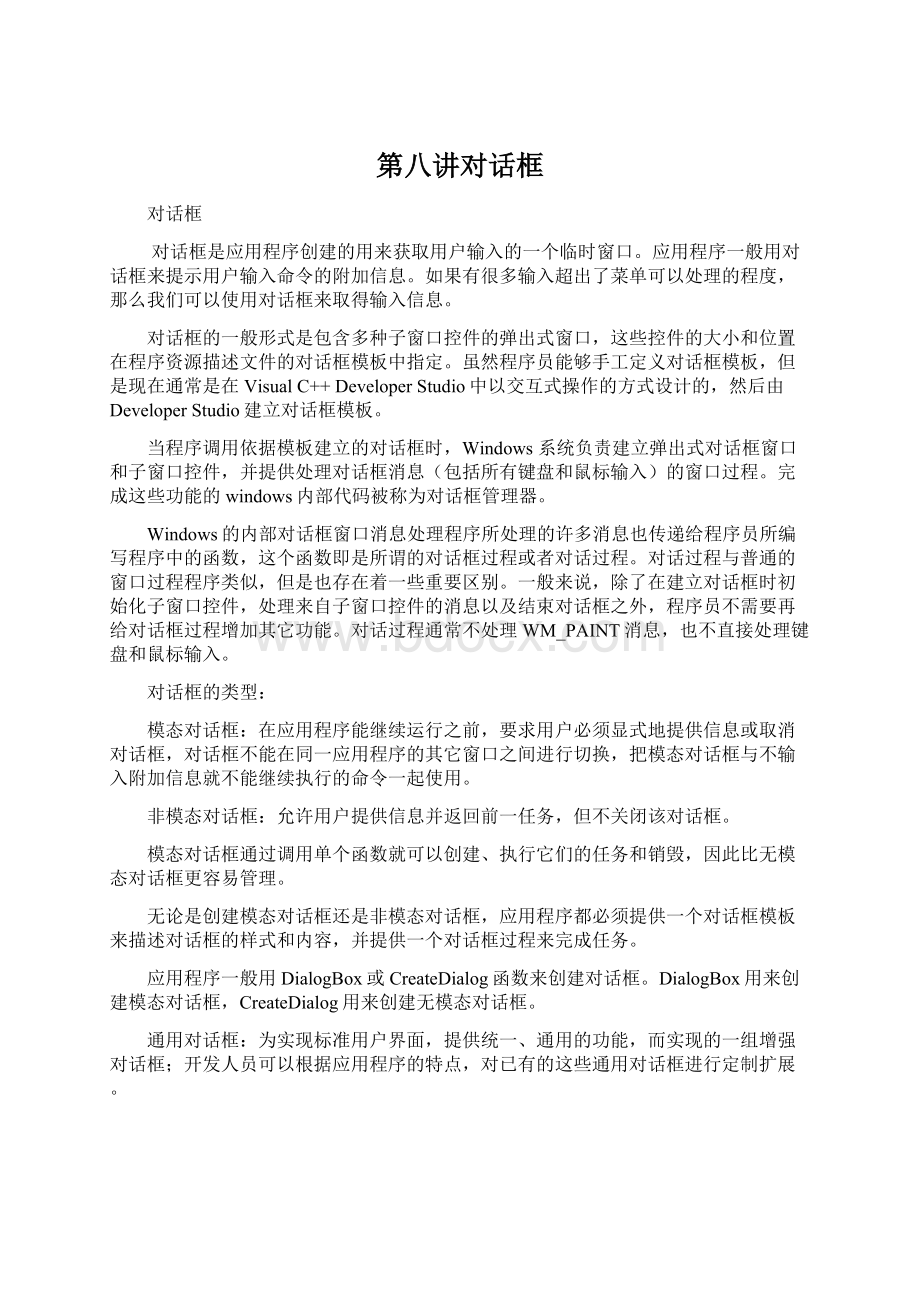第八讲对话框Word格式.docx
《第八讲对话框Word格式.docx》由会员分享,可在线阅读,更多相关《第八讲对话框Word格式.docx(13页珍藏版)》请在冰豆网上搜索。

无论是创建模态对话框还是非模态对话框,应用程序都必须提供一个对话框模板来描述对话框的样式和内容,并提供一个对话框过程来完成任务。
应用程序一般用DialogBox或CreateDialog函数来创建对话框。
DialogBox用来创建模态对话框,CreateDialog用来创建无模态对话框。
通用对话框:
为实现标准用户界面,提供统一、通用的功能,而实现的一组增强对话框;
开发人员可以根据应用程序的特点,对已有的这些通用对话框进行定制扩展。
每一个对话框都有一个属主窗口,应用程序在创建对话框时应指定一个属主窗口。
若属主窗口被隐藏或销毁,对话框同时被隐藏或销毁。
一个对话框可以没有属主窗口,但不建议这样使用,例如一个模态对话框没有属主,Windows就不会使其他窗口无效,这样就达不到使用模态对话框的目的。
如果一个非模态对话框没有属主,那么当应用程序的其他窗口被隐藏或销毁时,Windows不会隐藏和销毁该对话框,这就要求应用程序完成特殊的处理工作,以便在合适的时机隐藏和销毁该对话框。
消息框:
消息框也是一个对话框,但是Windows完全控制了消息框的创建和管理。
这就意味着应用程序不用提供对话框模板和对话框过程。
应用程序在创建该对话框时还可以指定MB_SYSTEMMODA来弹出一个系统消息框,这个消息框会挂起所有运行中的应用程序,用来向用户提出严重警告等信息。
模态对话框是一个弹出窗口,包含System菜单、标题栏和粗边界。
对于模态对话框WS_VISIBLE风格没有效果。
应用程序决不能创建一个具有WS_CHILD样式的模态对话框,具有这种风格的模式对话框将使自己无效,从而使应用程序不能继续。
应用程序调用DialogBox或者DialogBoxIndirect就可以创建模态对话框。
所不同处在于DialogBox要求一个模板资源名,而DialogBoxIndirect要求一个模板的内存对象句柄。
模态对话框一创建,Windows自动将它变成活动窗口。
属主窗口以及其子窗口都被变成无效的。
当模态对话框活动时,用户或应用程序都不应使属主窗口成为活动的。
为了处理模态对话框的消息,Windows启动一个临时消息环接管整个应用程序消息队列。
如果Windows收到一条明显不是对话框的消息,就把它发送给正确的窗口(非排队消息)。
如果发现一条WM_QUIT消息,则把它投递给应用程序的消息队列,以便使应用程序主消息环最终能够收到该消息。
只要应用程序的消息队列为空,Windows就把WM_ENTERIDLE消息发送给属主窗口,使得应用程序能够在对话框仍然存在的情况下进行后台任务处理。
但是这样并不理想,可以使用PeekMessage来交出控制权,也可以对对话框使用DS_NOIDLEMSG风格来禁止Windows发送该消息。
使用EndDialog来终止一个对话框,并且返回一个值来指明是否成功的完成了任务。
模态对话框的内部实现原理
DialogBox//#defineDialogBox…DialogBoxParam…
DialogBoxParam
逐层向上查找祖先窗口,直到找到一个具有popup或overlapped风格的窗
口作为父窗口
禁用父窗口//父窗口不再处理鼠标和键盘消息
CreateDialogParam//创建模态对话框(父、子窗口)
SetWindowWord(hwndDlg,DWL_ENDDIALOGCALLED,FALSE);
//设置
私有数据
while(!
GetWindowWord(hwndDlg,DWL_ENDDIALOGCALLED)){//有自己的消
息环
GetMessage(&
msg,NULL,0,0);
if(!
IsDialogMessage(hwndDlg,&
msg)){
TranslateMessage(&
msg);
DispatchMessage(&
}
DestroyWindow(hwndDlg);
//销毁窗口
结束模态对话框:
EndDialog
获取父窗口句柄
启用父窗口//父窗口继续处理鼠标和键盘消息
SetWindowLong(hwnd,DWL_ENDDIALOGCALLED,TRUE);
//设置私有数据
SetWindowLong(hwnd,DWL_DLGRESULT,nResult);
//设置返回值
模态对话框举例:
YoucreateamodaldialogboxbyusingtheDialogBoxfunction.Youmustspecifytheidentifierornameofadialogboxtemplateresourceandapointertothedialogboxprocedure.TheDialogBoxfunctionloadsthetemplate,displaysthedialogbox,andprocessesalluserinputuntiltheuserclosesthedialogbox.
Inthefollowingexample,theapplicationdisplaysamodaldialogboxwhentheuserclicksDeleteItemfromanapplicationmenu.Thedialogboxcontainsaneditcontrol(inwhichtheuserentersthenameofanitem)andOKandCancelbuttons.ThecontrolidentifiersforthesecontrolsareID_ITEMNAME,IDOK,andIDCANCEL,respectively.
Thefirstpartoftheexampleconsistsofthestatementsthatcreatethemodaldialogbox.Thesestatements,inthewindowprocedurefortheapplication'
smainwindow,createthedialogboxwhenthesystemreceivesaWM_COMMANDmessagehavingtheIDM_DELETEITEMmenuidentifier.Thesecondpartoftheexampleisthedialogboxprocedure,whichretrievesthecontentsoftheeditcontrolandclosesthedialogboxuponreceivingaWM_COMMANDmessage.
Thefollowingstatementscreatethemodaldialogbox.Thedialogboxtemplateisaresourceintheapplication'
sexecutablefileandhastheresourceidentifierDLG_DELETEITEM:
caseWM_COMMAND:
switch(LOWORD(wParam))
{
caseIDM_DELETEITEM:
if(DialogBox(hinst,
MAKEINTRESOURCE(DLG_DELETEITEM),
hwnd,(DLGPROC)DeleteItemProc)==IDOK)
{
//Completethecommand;
szItemNamecontainsthe
//nameoftheitemtodelete.
}
else
//Cancelthecommand.
}
break;
return0L;
Inthisexample,theapplicationspecifiesitsmainwindowastheownerwindowforthedialogbox.Whenthesysteminitiallydisplaysthedialogbox,itspositionisrelativetotheupperleftcorneroftheownerwindow'
sclientarea.TheapplicationusesthereturnvaluefromDialogBoxtodeterminewhethertoproceedwiththeoperationorcancelit.Thefollowingstatementsdefinethedialogboxprocedure.
charszItemName[80];
//receivesnameofitemtodelete.
BOOLCALLBACKDeleteItemProc(HWNDhwndDlg,UINTmessage,WPARAMwParam,LPARAMlParam)
{
switch(message)
caseIDOK:
if(!
GetDlgItemText(hwndDlg,ID_ITEMNAME,
szItemName,80))
*szItemName=0;
//Fallthrough.
caseIDCANCEL:
EndDialog(hwndDlg,wParam);
returnTRUE;
returnFALSE;
}
Inthisexample,theprocedureusesGetDlgItemTexttoretrievethecurrenttextfromtheeditcontrolidentifiedbyID_ITEMNAME.TheprocedurethencallstheEndDialogfunctiontosetthedialogbox'
sreturnvaluetoeitherIDOKorIDCANCEL,dependingonthemessagereceived,andtobegintheprocessofclosingthedialogbox.TheIDOKandIDCANCELidentifierscorrespondtotheOKandCancelbuttons.AftertheprocedurecallsEndDialog,thesystemsendsadditionalmessagestotheproceduretodestroythedialogboxandreturnsthedialogbox'
sreturnvaluebacktothefunctionthatcreatedthedialogbox.
使用CreateDialog或CreateDialogIndirect创建非模态对话框。
这两个函数返回对话框的句柄。
非模态对话框既不使属主窗口无效,也不给他发送消息。
应用程序要负责为对话框捡取和分发输入消息(共用一个消息队列)。
为了允许用户用键盘移动到并选择控制框,应用程序必须调用IsDialogMessage来判断消息是否来自对话框。
应用程序通过DestroyWindow来销毁一个无模式对话框。
CreateDialog函数内部利用CreateWindowEx创建非模态对话框,然后向对话框窗口过程发送WM_INITDIALOG消息,如果在对话框模板中指定了WS_VISIBLE风格,CreateDialog函数就马上显示这个新创建的对话框,最后返回对话框的窗口句柄。
非模态对话框的内部实现原理
CreateDialog//#defineCreateDialog…CreateDialogParam…
CreateDialogParam
FindResource//在exe文件中查找并定位对话框模板
LoadResource
CreateDialogIndirectParam//根据内存块中的对话框模
//板创建父、子窗口
FreeResource
返回创建的对话框窗口句柄//注意与模态对话框的区别
修改创建此对话框线程的消息环
while(GetMessage(&
msg,NULL,0,0))
{
if(hDlgModeless==0
&
&
!
IsDialogMessage(hDlgModeless,&
msg))
if(!
TranslateAccelerator(hwnd,hAccel,&
msg))
TranslateMessage(&
DispatchMessage(&
非模态对话框的销毁
caseWM_CLOSE:
DestroyWindow();
hDlgModeless=NULL;
对话框过程:
对话框过程类似窗口过程,但并不一样。
对话框过程处理一些程序设计者需要处理的消息,并返回TRUE,对于他不处理的消息,返回FALSE,由Windows传递给默认的窗口过程处理。
对话框过程不应当调用DefWindowProc。
绝大部分情况下,对话框过程通常只需要处理如下两种消息:
WM_INITDIALOG:
是对话框过程函数在对话框被显示之前接收到的消息,它是对话框过程函数接收到的第一个消息,用于完成初始化工作。
WM_COMMAND:
在对话框过程函数中处理来自子控件的消息。
非模态对话框举例:
YoucreateamodelessdialogboxbyusingtheCreateDialogfunction,specifyingtheidentifierornameofadialogboxtemplateresourceandapointertothedialogboxprocedure.CreateDialogloadsthetemplate,createsthedialogbox,andoptionallydisplaysit.Yourapplicationisresponsibleforretrievinganddispatchinguserinputmessagestothedialogboxprocedure.
Inthefollowingexample,theapplicationdisplaysamodelessdialogbox—ifitisnotalreadydisplayed—whentheuserclicksGoTofromanapplicationmenu.Thedialogboxcontainsaneditcontrol,acheckbox,andOKandCancelbuttons.Thedialogboxtemplateisaresourceintheapplication'
sexecutablefileandhastheresourceidentifierDLG_GOTO.Theuserentersalinenumberintheeditcontrolandchecksthecheckboxtospecifythatthelinenumberisrelativetothecurrentline.ThecontrolidentifiersareID_LINE,ID_ABSREL,IDOK,andIDCANCEL.
Thestatementsinthefirstpartoftheexamplecreatethemodelessdialogbox.Thesestatements,inthewindowprocedurefortheapplication'
smainwindow,createthedialogboxwhenthewindowprocedurereceivesaWM_COMMANDmessagehavingtheIDM_GOTOmenuidentifier,butonlyiftheglobalvariablehwndGotodoesnotalreadycontainavalidhandle.Thesecondpartoftheexampleistheapplication'
smainmessageloop.TheloopincludestheIsDialogMessagefunctiontoensurethattheusercanusethedialogboxkeyboardinterfaceinthismodelessdialogbox.Thethirdpartoftheexampleisthedialogboxprocedure.TheprocedureretrievesthecontentsoftheeditcontrolandcheckboxwhentheuserclickstheOKbutton.TheproceduredestroysthedialogboxwhentheuserclickstheCancelbutton.
HWNDhwndGoto=NULL;
//windowhandleofdialogbox
.
caseIDM_GOTO:
IsWindow(hwndGoto))
hwndGoto=CreateDialog(hinst,
MAKEINTRESOURCE(DLG_GOTO),
hwnd,(DLGPROC)GoToProc);
ShowWindow(hwndGoto,SW_SHOW);
Intheprecedingstatements,CreateDialogiscalledonlyifhwndGotodoesnotcontainavalidwindowhandle.Thisensuresthattheapplicationdoesnotdisplaytwodialogboxesatthesametime.Tosupportthismethodofchecking,thedialogproceduremustsethwndGototoNULLwhenitdestroysthedialogbox.
Themessageloopforanapplicationconsistsofthefollowingstatements:
BOOLbRet;
while((bRet=GetMessage(&
msg,NULL,0,0))!
=0)
if(bRet==-1)
//handletheerrorandpossiblyexit
elseif(!
IsWindow(hwndGoto)||!
IsDialogMessage(hwndGoto,&
TheloopchecksthevalidityofthewindowhandleforthedialogboxandonlycallstheIsDialogMessagefunctionifthehandleisvalid.IsDialogMessageonlyprocessesthemessageifitbelongstothedialogbox.Otherwise,itreturnsFALSEandtheloopdispatchesthemessagetotheappropr